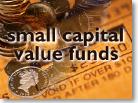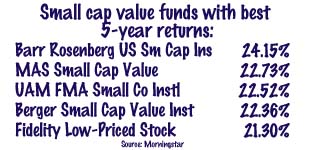|
Value without glamour
|
 |
June 4, 1998: 5:42 p.m. ET
Small cap value funds are performing better than small cap growth funds
|
NEW YORK (CNNfn) - As a small cap value investor, Curtis Jensen's mantra is safe and cheap.
Jensen, co-manager of the Third Avenue Small-Cap Value Fund, searches the universe of small cap stocks for companies that are the forgotten, unpopular and decidedly un-sexy stepchildren of Wall Street.
"Our investment philosophy leads us to invest in things that aren't cosmetically correct," said Jensen. "We invest in offbeat stuff, in sectors that are out of favor."
Small cap stocks are companies with a market capitalization of less than $1 billion. Within that umbrella are small cap growth and small cap value stocks.
Growth vs. value
Growth companies are the darlings of the investment world, with a high price-earnings ratio but even higher expectations. (The P/E ratio, also called the multiple, is the stock price divided by the earnings per share).
Value companies, on the other hand, are for contrarian, conservative investors. Their multiples are low and their stock prices look beaten-down. Beneath the surface, however, they are financially strong and their future is bright.
Why bother with small cap value stock funds? They're outperforming their flashier cousins, said Satya Pradhuman, director of small cap research at Merrill Lynch in New York.
"Small cap value stocks are the lesser known part of the small cap market, and they're very different," Pradhuman said.
Small cap value funds are up this year an average of 6.25 percent as of May 31, according to Russ Kinnel, head of equity fund research at Morningstar Inc., a Chicago mutual-fund tracker. But small cap growth funds gained only 4.2 percent in the same time.
Small cap growth funds had been ahead in 1998 until May, when they got hit hard by a souring of the tech sector, said Claudia Mott, director of small cap research at Prudential Securities in New York.
Amid widespread fears about the impact of the Asian crisis on U.S. companies, Hewlett-Packard Co. (HWP) announced it expected lower second-quarter profits. Growth funds in May lost 6.98 percent, while value funds lost just 4.07 percent.
"Small cap value funds tend to hold up better when the market is down," Mott said.
Kinnel said the P/E ratios of small cap growth funds make them more volatile. Since they're newer stocks with higher expectations, they have a less loyal following and get hit harder when they disappoint investors, he said.

But not everyone is rushing to buy small caps. Jim Meyer, director of research at Janney Morgan Scott in Philadelphia, pointed out that large-caps have handily outperformed small caps. And within the small cap value world, he questioned how long an investor has to wait until a company "gets discovered."
Another problem is small cap value funds are hard to find. Of the 20 funds in the category with the best five-year returns, 13 are either closed or unavailable to retail investors, according to Morningstar's Michael Stout.
The bigger a small cap value fund gets, the harder it is to manage. If assets grow too fast, managers have a tough time finding enough undervalued gems. Or, they have to buy too large a stake in a company so the holding becomes hard to sell. A fund's existing holdings might also perform so well they no longer fit the definition of a small cap value stock.
" 'Value' almost by definition has a ceiling on it," Mott said.
Many good small cap value funds, such as Neuberg & Berman Genesis Fund (NBGNX), and Fidelity's Low-Priced Stock Fund (FLPSX), have closed, Stout said. In 1997, assets in small cap value funds increased 72 percent, he said.
Third Avenue Funds sensed that interest in small cap funds when it launched the Third Avenue Small-Cap Value Fund (TASCX) in April 1997, Jensen said. With $166 million in assets, it earned 7.99 percent as of June 1, according to Morningstar.
Jensen said the fund has a significant presence in Japan, with a 5.8 percent holding in Nissan Fire & Marine. The fund also has a 7.1 percent stake in the semiconductor equipment industry.
"We view ourselves as true value investors," Jensen said.
The UAM FMA Small Company Fund (FMACX), ranked one of the top five-year performers in the category by Morningstar, buys stock with a discounted P/E compared with the Russell 2000 index, said Kathy Vorisek, vice president and portfolio manager.
The fund, which has $187 million in assets, holds a 3 percent stake in Earthgrains (EGR), a St. Louis, Mo. baking company that spun off from Anheuser-Busch Co. (BUD) in 1996.
In 1997, the fund was up 40.39 percent, but has languished this year, up a scant .94 as of June 1. Vorisek said it has been hurt this year in part because the energy sector is down.
Of course, there's nothing flashy about semiconductor equipment or the baking business, Vorisek said. But the advantage of small cap value funds is they give investors good returns over the long term.
"It doesn't have the sexiness of a growth portfolio, or an exciting brand-new tech name," Vorisek said. "But we can score as many or more home runs."
-- by staff writer Martine Costello
|
|
|
|
|
 |

|

